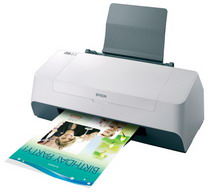Inkjet printer
An inkjet printer is any printer that places extremely small droplets of ink onto paper to create an image.

Inkjet Printer
Advantages
Compared to earlier consumer-oriented colour printers, inkjets have a number of advantages. They are quieter in operation than impact dot matrix or daisywheel printers.
They can print finer, smoother details and many consumer inkjets with photographic-quality printing are widely available.
There is no warm up time and lower cost per page (except when compared to laser printers).
Disadvantages
Inkjet printers may have a number of disadvantages:
- The ink is often very expensive.
- Many "intelligent" ink cartridges contain a microchip that communicates the estimated ink level to the printer; this may cause the printer to display an error message, or incorrectly inform the user that the ink cartridge is empty.
- The lifetime of inkjet prints produced by inkjets using aqueous inks is limited; they will eventually fade and the color balance may change.
- Because the ink used in most consumer inkjets is water-soluble, care must be taken with inkjet-printed documents to avoid even the smallest drop of water, which can cause severe "blurring" or "running." Similarly, water-based highlighter markers can blur inkjet-printed documents.
- The very narrow inkjet nozzles are prone to clogging with dried ink.
- They print slowly as compared to a laser printer.
Applications which require portability and low volume output and where changing cartridges is not an issue. e.g. small offices and stand alone systems.
Applications which require very high quality output and where speed is not an issue, e.g. digital camera applications.




